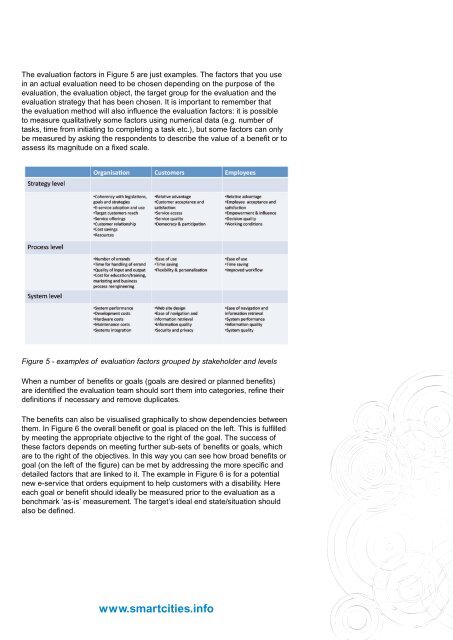Evaluating the impact of local e-services - Smart Cities
Evaluating the impact of local e-services - Smart Cities
Evaluating the impact of local e-services - Smart Cities
Create successful ePaper yourself
Turn your PDF publications into a flip-book with our unique Google optimized e-Paper software.
The evaluation factors in Figure 5 are just examples. The factors that you use<br />
in an actual evaluation need to be chosen depending on <strong>the</strong> purpose <strong>of</strong> <strong>the</strong><br />
evaluation, <strong>the</strong> evaluation object, <strong>the</strong> target group for <strong>the</strong> evaluation and <strong>the</strong><br />
evaluation strategy that has been chosen. It is important to remember that<br />
<strong>the</strong> evaluation method will also influence <strong>the</strong> evaluation factors: it is possible<br />
to measure qualitatively some factors using numerical data (e.g. number <strong>of</strong><br />
tasks, time from initiating to completing a task etc.), but some factors can only<br />
be measured by asking <strong>the</strong> respondents to describe <strong>the</strong> value <strong>of</strong> a benefit or to<br />
assess its magnitude on a fixed scale.<br />
Figure 5 - examples <strong>of</strong> evaluation factors grouped by stakeholder and levels<br />
When a number <strong>of</strong> benefits or goals (goals are desired or planned benefits)<br />
are identified <strong>the</strong> evaluation team should sort <strong>the</strong>m into categories, refine <strong>the</strong>ir<br />
definitions if necessary and remove duplicates.<br />
The benefits can also be visualised graphically to show dependencies between<br />
<strong>the</strong>m. In Figure 6 <strong>the</strong> overall benefit or goal is placed on <strong>the</strong> left. This is fulfilled<br />
by meeting <strong>the</strong> appropriate objective to <strong>the</strong> right <strong>of</strong> <strong>the</strong> goal. The success <strong>of</strong><br />
<strong>the</strong>se factors depends on meeting fur<strong>the</strong>r sub-sets <strong>of</strong> benefits or goals, which<br />
are to <strong>the</strong> right <strong>of</strong> <strong>the</strong> objectives. In this way you can see how broad benefits or<br />
goal (on <strong>the</strong> left <strong>of</strong> <strong>the</strong> figure) can be met by addressing <strong>the</strong> more specific and<br />
detailed factors that are linked to it. The example in Figure 6 is for a potential<br />
new e-service that orders equipment to help customers with a disability. Here<br />
each goal or benefit should ideally be measured prior to <strong>the</strong> evaluation as a<br />
benchmark ‘as-is’ measurement. The target’s ideal end state/situation should<br />
also be defined.<br />
www.smartcities.info



